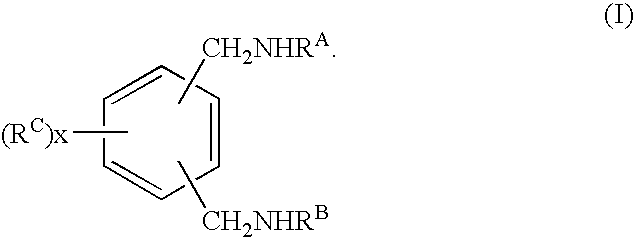Curing agent for low temperature cure applications
a cure agent and low temperature technology, applied in the field of dmmxda, can solve the problems of stress crack failure of coating, increase in severity of problem, and dramatically affect shipyard productivity
- Summary
- Abstract
- Description
- Claims
- Application Information
AI Technical Summary
Benefits of technology
Problems solved by technology
Method used
Image
Examples
examples
[0180]The invention is further illustrated by the following examples, which are not to be construed in any way as imposing limitations to the scope of this invention. Various other aspects, embodiments, modifications, and equivalents thereof which, after reading the description herein, may suggest themselves to one of ordinary skill in the art without departing from the spirit of the present invention or the scope of the appended claims.
[0181]Coatings of amine-epoxy compositions were prepared and tested as follows. Hardener mixtures or compositions, including amine compositions in accordance with the present invention, were prepared by contacting and mixing the components given in the tables that follow. The respective hardener mixture or composition, or the individual hardener, was then mixed with a multifunctional epoxy resin at the use level indicated in the tables in parts per hundred weight resin (PHR). The epoxy resin used in these examples, unless specified otherwise, was the...
examples 3-4
Synthesis of a Mixture of Amines Containing DM-MXDA Using a Two Stage Process
[0189]Tables 2-3 summarize the reaction conditions and materials utilized in Examples 3 and 4, as well as an analysis of the intermediate and final reaction products. In Example 3, 50 g of THF, 20 g of 1,3 dicyanobenzene, and 0.2 g of 5% Pd / C catalyst were placed in a 250-ml stainless-steel batch pressure reactor equipped with a stirrer and a hydrogen ballast tank. The reactor was purged with nitrogen and sealed. While stirring the reactor contents, 34 g of methylamine (MMA) were added to the reactor. The reactor was then pressurized with hydrogen to 375 psi (2.6 MPa) and heated to 125° C. These reaction conditions were maintained for 1000 minutes, then the reactor was cooled to room temperature and depressurized.
[0190]As shown in Table 2, the resultant intermediate product (first stage product) was high in imine content. In the second stage of the process, the intermediate product was hydrogenated at 125° ...
examples 5-6
Synthesis of a Mixture of Amines Containing DM-MXDA Using a Two Stage Process
[0193]Tables 2-3 summarize the reaction conditions and materials utilized in Examples 5 and 6, as well as an analysis of the intermediate and final reaction products. Example 5 employed substantially the same procedure as that of Example 3. A 5% Rh / Al2O3 catalyst, commercially available from BASF, was used in Example 5. At the end of the first stage, the composition of the intermediate reaction product contained 73% of the respective di-imine. The Rh / Al2O3 catalyst was removed by filtration, and a 5% Pd / C catalyst was used for the hydrogenation step. The resulting mixture of amines had a very high yield of DM-MXDA (73%) with about 15% MM-MXDA. Further details are provided in Tables 2-3.
[0194]Example 6 employed substantially the same procedure as that of Example 5. In the second step of the process, a Raney Nickel catalyst was employed as the hydrogenation catalyst. The final amine reaction product contained...
PUM
| Property | Measurement | Unit |
|---|---|---|
| temperatures | aaaaa | aaaaa |
| hydrogen pressure | aaaaa | aaaaa |
| hydrogen pressure | aaaaa | aaaaa |
Abstract
Description
Claims
Application Information
 Login to View More
Login to View More - R&D
- Intellectual Property
- Life Sciences
- Materials
- Tech Scout
- Unparalleled Data Quality
- Higher Quality Content
- 60% Fewer Hallucinations
Browse by: Latest US Patents, China's latest patents, Technical Efficacy Thesaurus, Application Domain, Technology Topic, Popular Technical Reports.
© 2025 PatSnap. All rights reserved.Legal|Privacy policy|Modern Slavery Act Transparency Statement|Sitemap|About US| Contact US: help@patsnap.com



